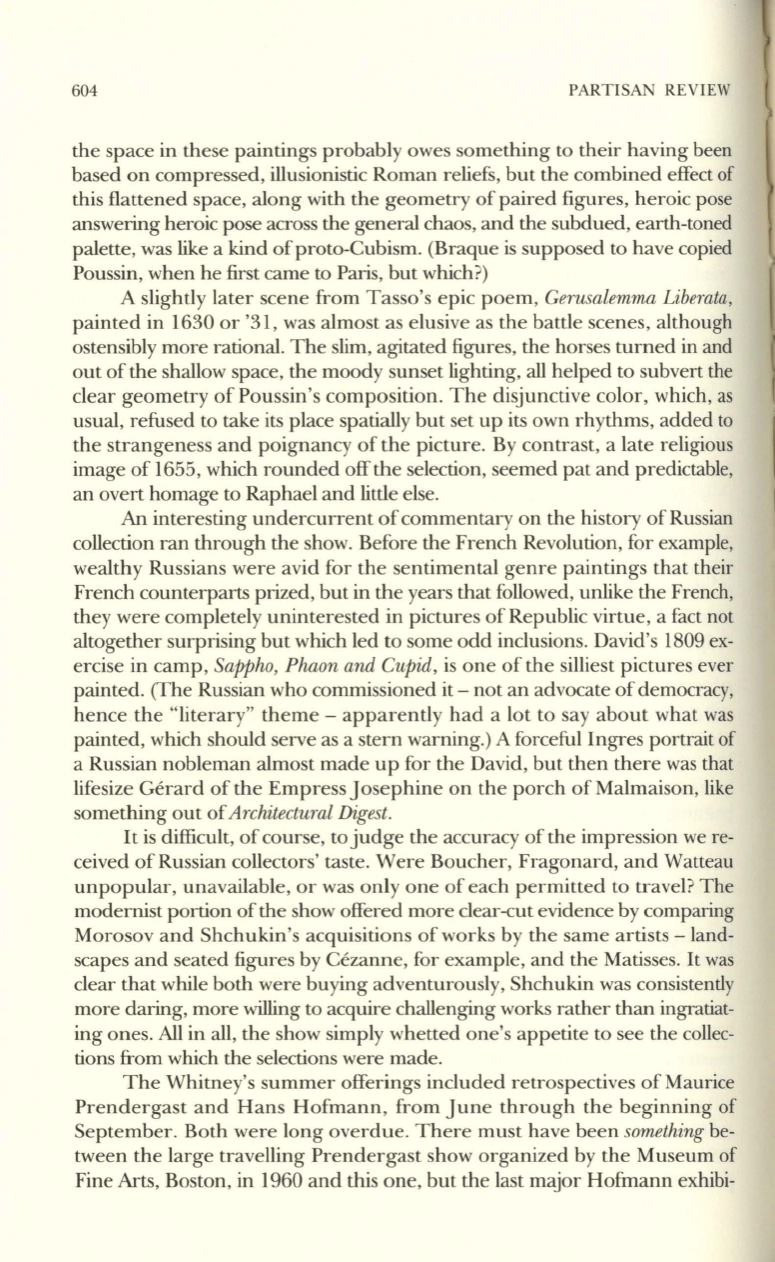
604
PARTISA REVIEW
the space in these paintings probably owes something to their having been
based on compressed, illusionistic Roman reliefs, but the combined effect of
this flattened space, along with the geometry of paired figures, heroic pose
answering heroic pose across the general chaos, and the subdued, earth-toned
palette, was like a kind of proto-Cubism. (Braque is supposed to have copied
Poussin, when he first came to Paris, but which?)
A slightly later scene from Tasso's epic poem,
Gerusalemma Liberata,
painted in 1630 or '31, was almost as elusive as the battle scenes, although
ostensibly more rational. The slim, agitated figures, the horses turned in and
out of the shallow space, the moody sunset lighting, all helped to subvert the
clear geometry of Poussin's composition. The disjunctive color, which, as
usual, refused to take its place spatially but set up its own rhythms, added to
the strangeness and poignancy of the picture. By contrast, a late religious
image of 1655, which rounded off the selection, seemed pat and predictable,
an overt homage to Raphael and little else.
An
interesting undercurrent of commentary on the history of Russian
collection ran through the show. Before the French Revolution, for example,
wealthy Russians were avid for the sentimental genre paintings that their
French counterparts prized, but in the years that followed, unlike the French,
they were completely uninterested in pictures of Republic virtue, a fact not
altogether surprising but which led to some odd inclusions. David's 1809 ex–
ercise in camp,
Sappho, Phaon and Cupid,
is one of the silliest pictures ever
painted. (The Russian who commissioned it - not an advocate of democracy,
hence the "literary" theme - apparently had a lot to say about what was
painted, which should serve as a stern warning.) A forceful Ingres portrait of
a Russian nobleman almost made up for the David, but then there was that
lifesize Gerard of the Empress Josephine on the porch ofMalmaison, like
something out of
Architectural Digest.
It is difficult, of course, to judge the accuracy of the impression we re–
ceived of Russian collectors' taste. Were Boucher, Fragonard, and Watteau
unpopular, unavailable, or was only one of each permitted to travel? The
modernist portion of the show offered more clear-cut evidence by comparing
Morosov and Shchukin's acquisitions of works by the same artists -land–
scapes and seated figures by Cezanne, for example, and the Matisses. It was
clear that while both were buying adventurously, Shchukin was consistently
more daring, more willing to acquire challenging works rather than ingratiat–
ing ones. All in ali, the show simply whetted one's appetite to see the collec–
tions from which the selections were made.
The Whitney'S summer offerings included retrospectives of Maurice
Prendergast and Hans Hofmann, from June through the beginning of
September. Both were long overdue. There must have been
something
be–
tween the large travelling Prendergast show organized by the Museum of
Fine Arts, Boston, in 1960 and this one, but the last major Hofmann exhibi-


